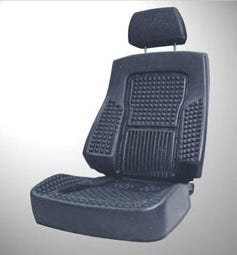The requirements for lower volatile organic compound (VOC) emission levels for automotive interior components continue to gain traction in the industry and the global marketplace. In response, The Woodbridge Group (Detroit, MI) has unveiled TrimVisible LE low emission molded foam technology, to meet the most stringent VOC specifications. This innovation provides best-in-class VOC reductions while its neutral color reportedly improves the appearance of apertures in a trimmed seat assembly.
January 28, 2014
The requirements for lower volatile organic compound (VOC) emission levels for automotive interior components continue to gain traction in the industry and the global marketplace. In response, The Woodbridge Group (Detroit, MI) has unveiled TrimVisible LE low emission molded foam technology, to meet the most stringent VOC specifications. This innovation provides best-in-class VOC reductions while its neutral color reportedly improves the appearance of apertures in a trimmed seat assembly.
|
Low VOC foam formulations can be realized via various strategies. |
Dave Miller, Senior Vice President, The Woodbridge Group, stated at the North American International Auto Show, "As a responsible supplier, Woodbridge has always manufactured products that are safe and compliant with the VOC level requirements of governments and original equipment manufacturers. The recent development of TrimVisible LE foams enables Woodbridge to meet extremely low VOC test requirements, with up to 80% reductions of some compounds without compromising seat cushioning performance, as tested through an independent accredited laboratory."
Woodbridge utilizes chemical expertise of automotive polyurethanes, in a three-prong strategy to offer best-in-class VOC performance foams.
1.Partnering with Suppliers - Woodbridge works with its raw material suppliers to reduce or eliminate VOC compounds in the various ingredients used to meet all customer requirements for the foam including physical properties.
2. Foam Formulation - Woodbridge develops its own formulations to avoid ingredients that unnecessarily contribute to VOC emissions from the finished product
3. Cancellation Technologies - In the event that the first two strategies cannot be employed to meet all of the product requirements specified by the customer, Woodbridge has also developed proprietary technology to mitigate various VOCs.
The Woodbridge Group and its partners in The World Polyurethane Alliance operate 60 facilities in 17 countries, as global leaders in the development and production of polyurethane and expanded polypropylene products. Automotive applications include components for seating, structural support, interior soft trim products, headliner systems, cargo management solutions, and engineered products for occupant protection and acoustical management. Woodbridge also offers contract assembly and sequencing and supply chain management, as well as a full range of value added services including engineering and design.
About the Author(s)
You May Also Like



